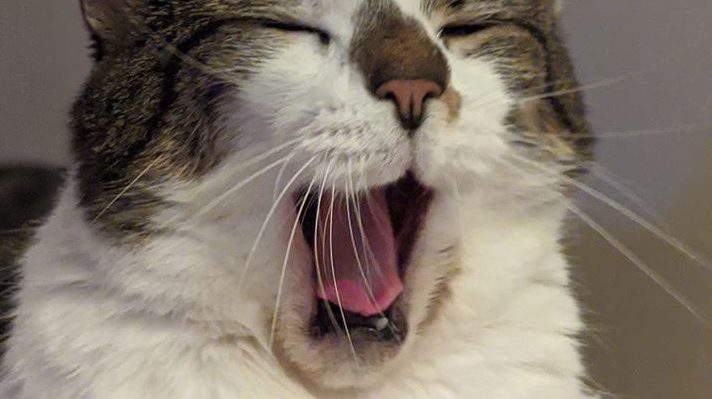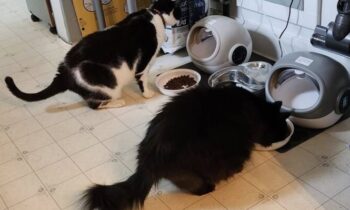


Cat lovers of today are thinking seriously about keeping their feline family members inside only, instead of allowing the cats to be indoor/outdoor. Indoor/outdoor usually means that the cat eats inside and stays inside as much as it wants, but that it is expected to run free and to eliminate outdoors.
Indoor/outdoor also means no litter box inside.
If you’re considering changing your indoor/outdoor cat to being an indoor-only cat, your first step should be to make sure the cat can (and will) comfortably and consistently use a litter box inside.
You may not know if your cat has ever used a litter box—that depends on how much you know about where the cat came from! You may be sure your cat has never used a litter box because you know where he’s been and what he’s been doing since the day he was born.
Even if that’s not the case, start the process by assuming the cat is unfamiliar with a litter box and what it’s for. If the cat surprises you by catching on immediately, all the better for both of you. If the cat takes a while to catch on? That would be normal.
I asked cat lovers and cat professionals for their advice.
Start with the litter box outside.
Ann Marie Danimus (Washington) I leave the litter box outside the door and then I move it inside the door. Simple.
Kristi Hanson (Louisiana) Start them off outside. The main thing is to get the litter box to appear attractive to the cats outside.
Micha Michlewicz (Maryland) Scattering natural materials on top can help the cat to identify it as a toilet. Like leaves, dirt—whatever the cat is used to going on outside.
Summer Storm Kingery DVM (North Carolina) Sand or dirt rather than litter. Consider a large surface area like a child’s wading pool. Consider placing cat-safe plants around it to “shelter” it.


Photo by Mandy Collins
Then move the litter box inside.
Christine Smith (Australia) When we have brought strays “home” after feeding them outside for a while to catch them, we put garden soil in a larger-size tray at first, because we figure that is what they are used to. It has seemed to work so far. This is adult cats, of course. Training kittens is a bit different, as they don’t have the “scratch and bury” habit yet. Most outdoor cats are used to doing just that, though—more so, really, than indoor cats who have never had to do it as a survival technique. Of course, there are sometimes accidents, but most “outdoor” cats are comfortable scratching and burying and they will look for dirt to do it in. We keep ours fairly contained within the house, though—the tray in the same room, and the cat not allowed to wander through the bedrooms, etc., until they are trustworthy. It can take a while.
Try a substrate that’s familiar.
Colette Kase (Mexico) Consider substrate preferences before you start. Find where the cat chooses to toilet outside and use that substrate for the litter box. Place the box close to where the cat toilets and give it plenty of privacy. If that doesn’t work, bring the cat indoors into a confined environment such as a bathroom or crate. Use that substrate in the litter box in that area. Gradually introduce your preferred litter as the cat becomes more used to using the tray.
Connie Price (California) I have mixed dirt from the outside to the cat litter. It’s just like changing over food: 3/4 dirt, 1/4 litter, and gradually switch it. And I use a large plastic storage container, in addition to regular litter boxes (for small kittens and older cats). It works great.
Use a litter box that’s big enough.
Monique Feyrecilde (Washington) A large converted storage tub for a litter box (for all cats). Mix the preferred substrate (soil, bark, grass, etc.) with litter, place in the desired location. Gradually decrease the amount of previous substrate and increase ratio of litter until the cat is comfortable using the litter alone.
Leanne Hugg (Florida) A large litter box (large, deep under-bed storage box with an entrance cut into it for access), then add the substrate the cat is currently using. Transition to new litter slowly, with preferred substrate on top. A normal-size cat box will likely be too small for a cat accustomed to having clear movement available. I would try dirt or sand . . . whatever the ground is where they live.
Amy Shojai (Texas) ^^^ This. Or leaves. Also, Cat Attract additive helps some cats.
Try a product that encourages use.
Jett Wyatt (Oregon) My feral cat just immediately used the litter box, once I trapped him inside. He was limited to one bedroom at the time (really, his choice), so perhaps restricting his access to the whole house helped. There is also a product called Dr. Elsey’s Cat Attract (I think they make a litter, as well) that seems to work for a lot of cats.
Lori Leah Monet DVM (Colorado) Dr Elsey’s Cat Attract and Feliway.
Dr. Elsey’s Cat Attract™ Cat Litter
https://www.drelseys.com/products/cat-attract-litter/
Feliway Happy Together
Start with an uncovered litter box.
If a cat has been eliminating outside, it is most likely she’s been doing so in an area that is protected but not necessarily covered. It seems sensible to make the litter box, when you’re introducing it, as much like where the cat’s been going as possible. Consider taking the cover off any litter box that has one, for the time it takes to get your cat comfortable with the primary goal: elimination.
Add on covers, doors, and accessories much later, when the cat is comfortable with the basic bathroom set-up sans frills. Think about the “shy” cat, though, when you place a litter box at any point in the acclimation process. Is privacy needed? If privacy is needed, do provide it!
Discourage failure to use the box.
One suggestion that makes sense for “accidents” when the cat has eliminated somewhere that is not a litter box—after you clean up, place a litter box in that location. I guess the message to the cat is, “You want to use this exact spot as a bathroom? Okay, here’s the bathroom. Go for it!” The goal of the extra litter box in the “oops” place is to give the cat a chance to be rewarded by using a litter box—any litter box, to start out. The reward for the cat is the relief of emptied bladder or bowels! Later, as the “primary” litter boxes are used regularly, you can experiment with putting the extras in storage.
Reward success in using the box.
The reward of emptied bladder and bowels is a potent one, but feel free to add any additional rewards you think might work well for your cat—that is, if you know what makes your cat feel rewarded!
Some cats like praise, some cats like petting, some cats like treats. Every cat is different!
You can’t decide what will make your cat feel rewarded—that is completely up to the cat—and it’s entirely situational, too, For example, your cat might eat treats at home where he feels confident, but refuse treats at your veterinarian’s office because he feels anxious there.
Try quietly enthusiastic praise for a start.
Give yourself a pat on the back while you’re at it. Transitioning a cat from pottying outside to pottying not only inside but also in a specific spot—that can take some patience and good humor!
It is the first step to transitioning your cat from outdoor to indoor-only, though, so if you’re successful in reaching that goal (which might not be easy), it bodes very well for the next steps of bringing your cat indoors completely . . . to live happily and healthily without any of the risks of a free-range life.



